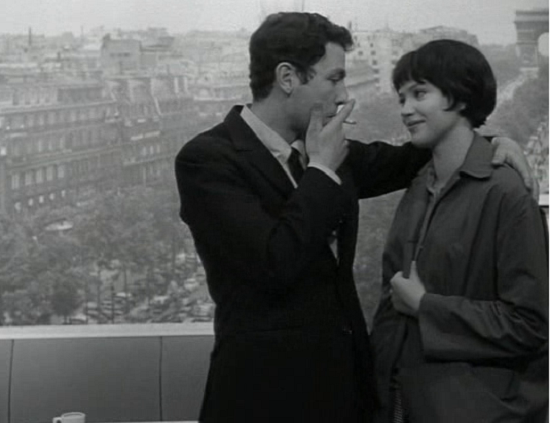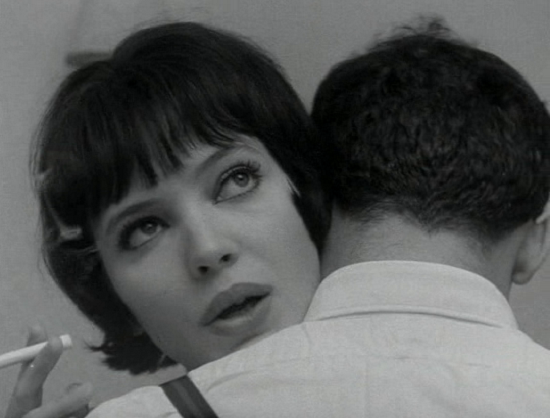Dec 24, 2025
Dec 24, 2025
Director: Jean-Luc Godard/ France/French /85mts
Jean-Luc Godard and the French New Wave were at the height of their power and creativity when Godard released Vivre sa vie (My life to Live) in 1962. And watching it again, years later, instantly transports one to the era where an offhand remark, a lazy circle of cigarette smoke, a sidelong glance, a disaffected "I don't care about you" could all communicate deep, conflicted longing, alienation, postwar malaise, and infinite possibility. In fact, watching Vivre sa vie, starring Godard's lovely muse, Anna Karina, as Nana is at once both enervating--and exhilarating.

Nana working in CD shop
Vivre sa vie was a turning point for Jean-Luc Godard and remains one of his most dynamic films, combining brilliant visual design with a tragic character study. The lovely Anna Karina, Godard’s greatest muse, plays Nana, a young Parisian who aspires to be an actress but instead ends up a prostitute; her downward spiral is depicted in a series of discrete tableaux of daydreams and dances. Featuring some of Karina and Godard’s most iconic moments—from her movie theater vigil with The Passion of Joan of Arc to her seductive pool-hall strut—Vivre sa vie is a landmark of the French New Wave that still surprises at every turn.

Nana watching the film "Passion of Joan of Arc"
Vivre sa vie presents 12 episodes in the life of a young woman who turns to prostitution to pay her rent. Each episode features a theatrical scene preceded by a title that lists the characters in the episode, its location, and a brief summary of the action. As he would throughout his career, director Jean-Luc Godard uses prostitution as a metaphor for both economic life in general and the position of the filmmaker under capitalism. Vivre sa vie stars Anna Karina, who was married to Godard at the time. Her performance was largely improvised as Godard refused to give Karina her lines until just before each scene was shot. In order to maintain the freshness of the performances, Godard rarely made more than one take of each shot. The film is shot in stunning black-and-white by Raoul Coutard. The improvised acting and fragmented story give the viewer the impression of watching a documentary about a woman's life that is also a series of essays about aesthetics and economics. In addition, the film's camera style presents a catalogue of alternatives to conventional shooting strategies

Nana struggling with the first customer
Karina’s character in Vivre sa vie is a Parisian in her early twenties named Nana. The film is a portrait of her life as a prostitute. In the opening scene, she calmly bids her farewell to Paul (André S. Labarthe), an aspiring musician with whom she had a son, and who raises the boy while still living at home with his parents. She wants to be an actress, and has gotten a little work on both the stage and in film, but most of her income is from her job as a floor associate in a record store. The money isn’t enough to pay the bills, and one day she finds herself locked out of her apartment because of past-due rent. It isn’t long before she starts turning tricks, first as an amateur streetwalker, and then as a professional in the employ of a pimp (Sady Rebbot), who puts her to work on both the street and in a brothel.

Nana with her friend
Godard repeatedly emphasizes how degrading the life of a prostitute is. When Nana turns her first trick, she tries to retain a shred a dignity by refusing to kiss the john on the mouth, but no matter how much she struggles and repeatedly turns her face away, he won’t take no for an answer. There are repeated shots of women lined up along the Paris streets offering themselves; Godard’s use of a car to dolly the camera makes the women seem like cuts of meat under scrutiny in a butcher’s display. Brothel work has a similarly demeaning side. One of Nana’s customers in that setting asks if he can have a threesome instead of a one-on-one, and then, after she goes to a fair amount of trouble to find another available girl, he decides he likes the second girl better and opts to be serviced by her alone. Nana is left to sit on the edge of the bed, smoking a cigarette while she listens to the john and the other girl have their session.

Nana writing a letter for working in a brothel
Each of the episodes in this film is done with precision and integrity. The movie begins with the camera focused on the back of the woman's head, with her face (only) reflected in the mirror. She talks to the mirror, not to her boyfriend beside her, about the pain of the breakup. Another episode involves her being in the audience at a movie theater showing another movie on screen: Carl Dreyer's "The Passion of Joan of Arc". She cries as she watches the scene in which Joan (Renée Jeanne Falconetti) comes to terms with her doom (Not coincidentally, Joan of Arc was punished by men for trying to act as one). Nana’s tears are as much for Joan as for herself, and Godard heightens the viewer’s sense of Nana’s identification with Joan by intercutting the Dreyer film’s close-ups of Falconetti with similarly posed close-ups of Karina.

Nana with her future pimp
In another episode, Nana finds a new beau and resolves to give up whoring. She’s spurred by his reading Baudelaire’s translation of Poe’s “The Oval Portrait” aloud; it’s obvious she transfers her love of the prose’s romantic spirit to her new boyfriend. One also finds Godard’s standard in-jokes, such as a shot of a theater playing fellow nouvelle vague filmmaker François Truffaut’s Jules and Jim.
The heart of the film, though, is Anna Karina’s superb performance. Every note is hit with close to perfect pitch, and that near-perfection is better than the total thing. Karina evokes the character; she doesn’t call attention to her virtuosity in playing the role. A very powerful episode is one where she dances around a pool table listening to jukebox music - it's a very famous part of the movie. This will be the first...and only time that we glimpse a smile on Nana's face. Even the occasional awkwardness of her movements in the jukebox-dancing scene seems right for the part. Her best scene is the one in which her future pimp convinces her to work for him. It begins with Nana writing a letter to an out-of-town madam to ask for work in her brothel. Karina conveys Nana’s trepidation with every stroke of the pen on the paper. Nana is interrupted by Raoul, who sees the letter and offers what he says is a better deal. One can see the character caught between her ongoing revulsion at selling herself and her eagerness for a better financial situation; the emotional shifts Karina evokes between a desire to refuse, coyness, ingratiating behavior, and Nana’s eventual wholehearted acceptance of his offer are nothing less than dazzling.

Her detached slip into prostitution
The film’s epigraph is a quote attributed to Montaigne, “One must lend oneself to others but give oneself to oneself.” However, Godard obviously intends this as ironic. Nana tries to live that attitude, as can be seen in one bit in which she proudly displays herself to passersby on the street. And it’s probably what’s behind her swaggering, flirtatious dance to a jukebox tune in an almost empty club. But the film makes perfectly clear that Nana doesn’t “give herself to herself”; she ultimately belongs to her pimp. Raoul terrorizes her at one point for refusing a client, and his view of her as his property is further emphasized when he tries to sell her for a large sum to another gangster. She’s just a piece of tradeable merchandise to these predators, and if they can’t make money off her, she’s no more to them than garbage on the street. The tragedy of Nana's life is that bad luck has taken away all her potential for happiness.

Dancing to a jukebox tune in an almost empty club
Godard’s stylistic trademarks are very much a part of Vivre sa vie. He does a marvelous job of integrating them into the material. No previous filmmaker has done as much to emphasize how much our experiences with the arts reflect and shape our attitudes and lives.

The final trade
One would be remiss not to applaud Godard for his refusal to be exploitative of Karina in this role. She does no nudity in the film; the most one sees are fleeting glimpses of her underwear as Nana begins to take off her clothes. Godard's handling of the montage of Nana with her various customers as she happily embarks on her ultimately tragic time in Raoul’s employ is exemplary. It’s accompanied by a dry, didactic voiceover that recounts the recent history of prostitution laws in France, the legal dos-and-don’ts for those engaged in the trade, and the women’s specifically feminine medical needs and practices. Godard won't for a moment allow the viewer to get any vicarious enjoyment out of Nana's experiences as a prostitute. There isn’t a prurient moment in the film. Even the threesome scene is handled with a minimum of explicitness; the only explicitly racy bits are the brief shots of Nana’s nude coworkers as she goes around the brothel looking for a girl who isn’t busy.
Vivre sa vie is a masterpiece of neorealism, a film that is enhanced by the understated acting of the lead actress. Vivre sa vie enjoys an extremely positive critical reputation as Godard’ most accomplished film. Susan Sontag, author and cultural critic, has described Godard's achievement in Vivre sa vie as "a perfect film" and "one of the most extraordinary, beautiful, and original works of art that I know of." According to critic Roger Ebert, "The effect of the film is astonishing. It is clear, astringent, unsentimental, abrupt."
A series of Hundred Favorite Films Forever"
06-Dec-2012
More by : P. G. R. Nair